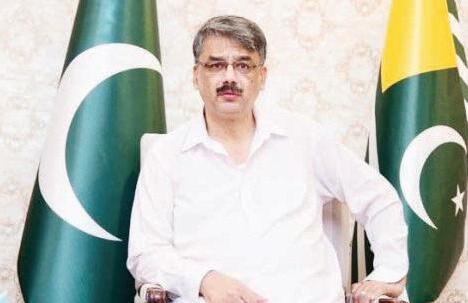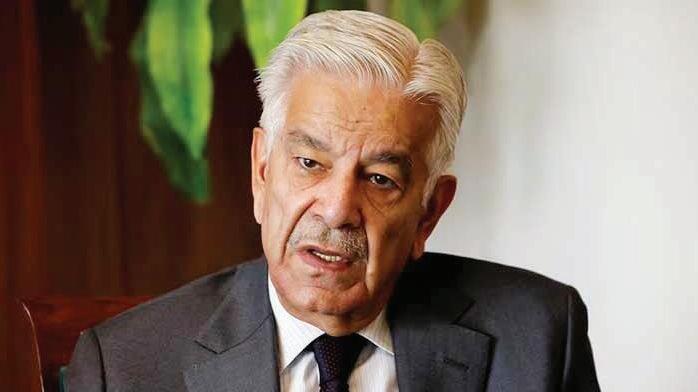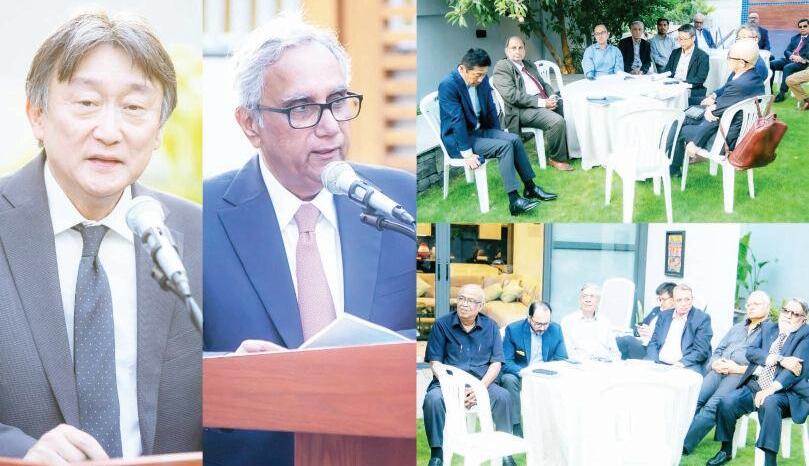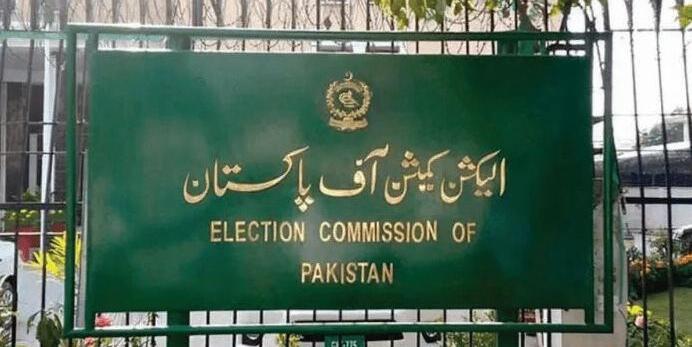

GLOBAL MARKET


needs he lauded the Special Investment Facilitation Council (SIFC) for fostering public–private collaboration and attracting investments in high-technology sectors He reaffirmed his government’s resolve to strengthen Pakistan’s digital and industrial capacity through education inclusion and global partnerships Empowering youth, women, and academia Federal Minister for IT and Telecommunication Shaza Fatima Khawaja said INSPIRE reflects the prime minister’s vi-

Minister Khawaja Asif on Tuesday urged a hard state approach
sion of a technology-driven, inclusive economy that empowers youth and women with advanced technical skills
This initiative will enable our students researchers and professionals to move from learning to leading roles in the global semiconductor industry, she said
She added that the ministry was actively building international partnerships and investment collaborations in areas such as semiconductor design broadband infrastructure and advanced manufacturing Creating Pakistan’s semiconductor ecosystem Dr Naveed Sherwani, Chairman of the National Semiconductor Task Force said INSPIRE represents the first phase of Pakistan s long-term semiconductor strategy
My vision for Pakistan s semiconductor future goes beyond training talent it s about building an interconnected ecosystem that unites academia, research, and industry,” he noted PSEB CEO Abu Bakar said the board would train 7 200 professionals over five years in semiconductor design verification, and research, working with nine public-sector universities and establishing six Integrated Circuit (IC) labs nationwide
As part of Pakistan’s National Semiconductor Development Roadmap INSPIRE will lay the groundwork for future Outsourced Assembly & Testing (OSAT) and fabrication capabilities, positioning Pakistan as a credible contributor to the trillion-dollar global chip supply chain
‘Challenges to 26th Amend’: Justice Mazhar likens benches to ‘branches of one tree’
Justice Muhammad Ali Mazhar on Tuesday observed that the Supreme Court’s regular and Constitutional Benches (CBs) were branches of one tree as an eightmember CB resumed hearing over three dozen petitions challenging the 26th Constitutional Amendment a law that redefined the apex court’s powers and structure The Amendment passed by Parliament in an overnight session in October last year has drawn sharp criticism from the opposition and legal community The PTI alleged that seven of its lawmakers were abducted to secure votes in favour of the legislation while the BNP-Mengal claimed its two senators were coerced before they broke ranks to support it The 26th Amendment curtailed the Supreme Court’s suo motu powers fixed the chief justice s term at three years and authorised a Special Parliamentary Committee to appoint the CJP from among the three most senior judges It also paved the way for forming Constitutional Benches one of which is now hearing challenges against the very amendment that created it According to the court s cause list, the CB has taken up 37 petitions questioning both the procedure and substance of the law, including its implications for judicial independence The hearing The eight-member bench is headed by Justice Aminuddin Khan and includes Justices Muhammad Ali Mazhar, Jamal Khan Mandokhail, Ayesha Malik, Syed Hasan Azhar Rizvi, Musarrat Hilali Naeem Akhtar Afghan and Shahid Bilal Hassan
changes could curtail judicial freedom and open doors to both internal and external control In a detailed letter addressed to the SJC chair and members, the two judges said they had submitted written comments ahead of the meeting and later revised them to reflect what they termed an unfortunate and constitutionally inappropriate move by the National Judicial
Policy-Making Committee (NJPMC) to deliberate on the Code a domain they said lies solely and exclusively within the jurisdiction of the SJC ” “These proposals if adopted will restrict judicial freedom transform an open and collegial institution into a closed and hierarchical one, and create avenues for control, both internal and external,” the judges cautioned The concerns surfaced after the Supreme Judicial Council (SJC) on October 18 approved wide-ranging changes to the Code, barring judges from engaging in public controversy or political discussion and introducing new restrictions on media interaction social conduct and diplomatic participation
During Tuesday s proceedings, retired Justice Syed Shabbar Raza Rizvi a former Lahore High Court judge concluded his arguments while Dr Adnan Khan counsel for petitioner Mohammad Anas, also presented his contentions The hearing was adjourned till 11:30am Wednesday


up by 1 103 93 points or 0 66% The index reached an intra-day high of 168,414 13 during the session, driven by strong performances in stocks such as BAHL, FFC, MCB, OGDC, and PPL, which collectively added 830 points to the index However profit-

Punjab launches tech- driven system to combat smog and improve air quality

NA committee demands inquir y into sugar expor t decisions as prices soar past
Masjid seen covered in the smog Murtaza Ali/ White Star Punjab Senior Minister Marriyum Aurangzeb announced the launch of a comprehensive, technology-driven system aimed at reducing smog and improving air quality across the province Speaking to a private news channel the minister highlighted the provincial government’s efforts to tackle environmental challenges through data-driven solutions and modern technology
Aurangzeb noted that in the past, the province s response to environmental issues was largely reactive The government lacked an efficient air quality monitoring system, environmental
‘C hallenges to 26th Amend ’: Justice M azhar likens benches to ‘ branches of one tree’
CONTINUED FROM PAGEI 01
tioned whether the CB had the author-
Aminuddin asked “Are you saying we should give power to those judges who do not have it under the law? Rizvi res
191A should be read alongside Article
drew parallels with the Federal Shariat Court’s powers under Article 187 saying both institutions could exercise authority to ensure complete justice Justice Mazhar agreed that the CB operated within the Supreme Court s structure, adding, “Regular bench and Constitutional Bench both are two branches of one tree ” DEBATE OVER FULL COURT At several points the judges ques-
As arguments continued, Justice Mandokhail observed that if the petitioner s stance was accepted that the Supreme Court and the CB were distinct it would mean the bench retained suo motu powers that had otherwise been removed from the court Justice Rizvi countered that the Amendment conferred powers on the CB without taking any away from the Supreme Court Justice Musarrat Hilali pointed out that Article 191A introduced through the Amendment had brought the Constitutional Bench into existence and asked whether reverting to a full bench would require suspending the Amendment itself Justice Mazhar noted that the powers under Article 184(3) the SC’s original jurisdiction had been transferred to the CB under Article 191A which “clearly mentioned the same Rizvi cited previo
matter ahead, but the judge noted that t h
quipping Look at our patience; we are continuously hearing lies while sitting here
BACKGROUND AND PETITIONS
So far senior lawyers Hamid Khan Munir A Malik, Barrister Salahuddin Ahmed, and Abid Shahid Zuberi have called for a 16-member full court, matching the strength of the Supreme Court when the Amendment was passed in October 2024
would ordinarily go was not part of the current CB Justice Mandokhail wondered whether the petitioner was implying that only a full court could hear the case Justice Mazhar cited India s example, noting that constitutional benches there were not referred to regular benches even though the CJP remained the “Master of the Roster” a concept no longer applicable in Pakistan Later Dr Adnan Khan argued that both a full court and the CB could hear the case,

COMMENT
TH E current account figure for the first quarter of the current fiscal year was a deficit of $594 billion reversing a small surplus of $110 million in August This has happened despite remittances from overseas Pakistanis being recorded at $9 54 billion in the first quarter, up 8 4 percent over the previous year s $8 8 billion The reason being ascribed is the increased import of food items This should illustrate why the policy of exporting existing surpluses as was done with sugar only last year is shortsighted The floods have caused doubt to be thrown on the wheat autarky of the country, though the Punjab s reintroducing of the wheat support price should encourage the sowing of wheat, countering the effects of the floods among farmers
Apart from that, the need to import food means that the foreign exchange requirements of the country are outside the hands of the government Luckily for it the global oil prices are expected to remain about where they are This may not be comfortable for the government, but it is tolerable There are clouds on that horizon, though, with the Sindh government about to introduce access of fuel imports, which the Oi Companies Advisory Council says could disrupt the supply chain and cause nationwide shortages The reserve position is relatively comfortable with the gold reserves having reached $5 4 billion without any new purchase, solely because of the increase in its price, and foreign exchange reserves reaching $14 28 billion, up considerably from $10 84 billion at the end of FY25 However, though exports have grown to $7 9 billion from Rs 7 4 billion last year, imports have grown faster 8 3 percent to $15 4 percent
Perhaps the government needs to concentrate on IT exports They have been promising, growing 29 percent year-on-year to $330 million in the first quarter That is ahead of the 27 percent annually that is needed to achieve the target of $10 billion by 2028 2029 However, there are unpredictable developments in


LA S T week the Arab American Institute Churches for Middle East Peace and the American Friends Service Committee brought a group of Palestinian Americans with family in Gaza to meet with members of Congress and media Their two-day presence in Washington was designed to give voice to Palestinian victims of Israel’s assault on Gaza and to put a human face on those who have suffered Our government officials have frequently met with and heard the stories of Israeli families Palestinians haven t had the same opportunity Planning for the Washington visit began months ago but was delayed by congressional recesses and the current government shutdown When our date had been finalized and President Donald Trump announced his peace plan a few naysayers expressed concern that the plan s signing might dampen interest in hearing from Palestinians Trump got his victory lap and photo ops in Israel and Egypt where leaders heaped praise on him Media commentators called the moment “historic” and “transformative ” and TV cameras recorded joyous demonstrations in Jerusalem and deeply emotional scenes of Israeli families reunited with loved ones held captive for two years For days papers included front-page stories of Israelis

Dam illusion


social discipline and economic order While her leadership is historic, her admiration for Thatcher signals a governing philosophy rooted in conviction and hierarchy rather than liberal reform Yet Japan’s demographic challenges constrain this vision The population declined by nearly 800 000 last year and one in ten citizens is now aged 80 or above Labour shortages have deepened across manufacturing and services Without immigration reform or large-scale automation, sustaining growth will prove increasingly difficult This tension between ideological conservatism and economic necessity defines Japan’s uncertainty In foreign policy Takaichi is expected to maintain Japan s alignment with the USA and other G7 economies Defence spending reached a record $56 billion in 2024, a 16 percent increase from the previous year Her support for revising Article 9 of the constitution, which restricts Japan’s use of military force signals a shift toward a more assertive regional role This assertiveness now extends to economic policy Industrial subsidies defence production and technology independence are being recast as instruments of national security As global trade becomes increasingly shaped by strategic alliances Japan’s model is shifting from exportled growth to selective self-reliance
The symbolism of Takaichi s leadership resonates beyond Japan She represents a generation of right-leaning leaders who combine market pragmatism with nationalist rhetoric Across the world, similar movements have gained ground, blending economic liberalisation with cultural revivalism The appeal lies in their rejection of centrist orthodoxy and their promise to restore both prosperity and pride Japan s trajectory thus reflects a broader redefinition of economic governance, where the state reasserts its authority not for welfare but for sovereignty and security

Japan s shift toward a more interventionist state will reshape the regional economic order Competition over semiconductors, rare earths, and renewable technologies will increasingly define Asia-Pacific power relations For Pakistan which maintains steady trade and development cooperation with Japan this transition may open new opportunities in technology and energy sectors, provided domestic reforms align with evolving global priorities
Japan remains one of Pakistan’s most consistent development partners with bilateral trade exceeding $2 4 billion in 2024 and extensive technical cooperation through the Japan International Cooperation Agency As Japan rebuilds its industrial base it could create new avenues for collaboration in renewable energy, automotive supply chains, and digital infrastructure
Takaichi’s rise embodies both ambition and uncertainty She represents a nation seeking renewal and one confronting structural limits Whether her economic vision succeeds will depend not only on fiscal design but also on Japan s ability to confront its demographic and productivity constraints Her ascent captures a global moment in which states are rewriting the rules of capitalism to serve nationalist ends The outcome of Japan’s experiment will reveal whether prosperity can coexist with protectionism and whether the global economic order can adapt to this new nationalism Japan stands, once again, as both participant and precursor, a society testing the boundaries between market openness and national strength
The writer is a transnational educational consultant freelance columnist and policy analyst
A gamble of alliances
Suleman Zia

When will the law rule?
aries to help the victim recover the robbed
Ewhich term well describes this
phrase has no impact on the people of
Kashmore, who have been living under this strange form of leviathan for decades A shout-out is a minimum the Nobel laureates duo deserve given their allocation of a term that best describes communities cultures or regions under circumstances virtually ungoverned by the existing leviathan District Kashmore, with the rare feature of connecting Pakistan s three provinces, is notoriously known for being a personal fiefdom of the bandits who reign and rule by choice The district’s population concomitantly has become subject for loot extortion and kidnapping on quotidian basis with the Hindu business community falling prey more frequently than other communities Shabby, bidirectional and earthen roads make loot and kidnappings easy pickings for the gun-powered unknown ghosts that prey on everything extractable Facilitators individual informers for potential prey ice the cake for actual performers that minimizes the risk to be caught (though that happens once in blue moon) red-handed and considerably reduces the on-spot robbery time The invisible (and virtually invincible) bandits majorly contribute to lawlessness by demanding monthly extortions in the district though the fresh uncaught criminals also do damage to add to overall banditry Essentially, the first-time offenders rob out of (probably) joblessness and a go-between mediated settlement pile the cases of plunder and lawlessness That is uncaught criminals extensively rob the formerly criminal now relinquished individuals act as intermedi-
materials for (almost) a ransom of half the actual cost Blackmailing honey trapping and extortion and other likewise income streams make banditry a parasitical profession that allows bandits to search for hosts, fully feed on them and leave Such a profitable profession allows notorious and uncaught criminals alike to roam on Facebook and other social sites to hunt the potential prey Plus their pretty much influential presence on social media causes social activists influencers journalists, and writers to become reluctant to write against, criticize or condemn their actions since any single post can bring one on the radar of these parasites To play safe, journalists and writers including this one preferably use this language for communication and awareness since by hook or crook the banditry perpetuates this parasitical practice for years
Too much repetition of identical practices robbery, extortion, kidnapping-forransom mirror the Somalian state of affairs: the absence of the state writ makes goons the new authority who rule by violence This may sound like a fictional story; however, it s the very fabric: weird, violent and vicious The banditry made irreparable dents on socioeconomic fronts though, and the attempts on educational development are most visible: under the veneer of personal blood feud more than dozens of enlightenment torchbearers have been killed with only two killing cases IBA professor Dr Muhammad Ajmal Sawand and a school teacher, Allah Rakhyo Nindwani have managed to come into the limelight thanks to the social media The rest went unreported Given the loopholes in the system and the existence of nexuses the law repeatedly fails to handcuff the perpetrators or their patrons Such surrender of the law verifies the existence of the “absent leviathan” and replenishment of the non-state actors
A place otherwise known as a ‘milieu of danger a no-go area and a red zone where the traffic travels in convoy where socioeconomic activities are shunned after dark, where the population feel as if virtually

living in a Hobbesian state of nature doing anything good such as teaching is no less than calling to danger Plus it is no safe zone for journalists (unless they submit to corruption and patronage) and other social activists that tend to harm the bandit raj Since power flows from the barrel of gun,
dare
against banditry (since nexuses, the other actors readily rescue the wanted ones in times of hardship rare as that is) and if
does stand one never gets away with
and hence pays the price one way or the other That is, the carefully curated structure, started with lawlessness, fueled by bandits, perpetuated by nexuses, signals to follow the old maxim: when in Rome do as Romans do When operating in Kashmore journalists writers truth seekers are invited to serve as minions sycophants else are warned
Restoration from lawlessness isnÊt a hard nut to crack; itÊs a mere transfer of power from self-ser ving local elites to the public. If the will is there , there is always a way. The situation is deteriorating by the day though, it is surefire that a quick, coordinated return to the basics will completely tumble all that doesnÊt let law prevail.
Why global internet outages keep happening
Past outages on this scale have been caused by a wide variety of errors, including faulty updates, the accidental injection of bad code, or a change to third-par ty software that doesn’t play nicely with a ser vice
Mendoza College of Business The reason these events attract much more notice is because of their impact, he told CNN If a single company experiences an issue in their data center, it causes issues for that company’s products and services ” In 2024 the largest-ever IT outage brought down large portions of the internet when a devastating CrowdStrike software glitch crashed computers, led to flight cancellations and disrupted hospitals around the globe, creating $5 billion in direct business losses A bug in CrowdStrike’s cloud-based testing system pushed a problematic update to computers around the world Also last year AT&T s network went down several times, including an 11-hour meltdown that prevented many gig workers from doing their jobs
SO, WHAT WENT WRONG MONDAY?
AWS is a cloud computing provider that hosts many of the world s most-used online services In Amazon s infancy the company needed excess server capacity to ensure it had enough computing power to handle the massive amounts of traffic that came to its site during the holiday season rush Amazon realized that during the rest of the year it could use those servers to support other companies online needs and out of that AWS was born Among AWS many offerings is DynamoDB, a database that hosts information for companies, including customer data Amazon said Monday that its customers couldn’t access the data stored in DynamoDB because the Domain Name System (DNS) – a kind of phone book for the internet – had encountered a problem DNS is like an internet location engine, converting user-friendly web addresses like amazon com into IP addresses – a series of numbers that other websites and applications can understand “Amazon had the data safely stored but nobody else could find it for several hours leaving apps temporarily sepa-
Power is most effec tively exercised when it need not constantly be exercised
WH E N Germany emerged as Europe’s industrial powerhouse in the 19th century the established powers spent years attempting to contain it, culminating in a war no serious statesman desired, yet none proved skilful enough to prevent Today, as we navigate the transition from American unipolarity a similar question looms: will this shift follow that tragic pattern or can it be managed through institutional adaptation as Zhou Enlai and Richard Nixon did in the early 1970s?
The multipolar order is not approaching; it’s already here Economic fundamentals have decided this outcome The only question is whether it will be managed through patient statecraft or approached through confrontation that risks catastrophic miscalculation
Two factors fundamentally distinguish today’s great power competition from past hegemonic transitions First the proliferation of nuclear weapons has created a dynamic of mutual assured destruction that renders total war irrational Putin s nuclear brinkmanship amid the Ukraine war shows not strength but desperation, simultaneously reminding all parties why direct great power confrontation has become strategically suicidal This doesn t eliminate conflict but it fundamentally changes the character of great power competition via proxy wars and economic confrontation Second, technological interdependence creates unprecedented costs for systemic rupture Semiconductor supply chains span multiple continents; artificial intelligence requires global talent pools China holds around US$730 billion in US Treasury securities The United States relies on Dutch equipment, Taiwanese fabrication and rare earth elements processed largely in mainland China to build advanced microchips China s technology objectives meanwhile depend on American design software Japanese precision machinery and Western market access These embedded relationships would be catastrophically disrupted by war between both powers, creating powerful domestic constituencies in all major economies that have a strong
In a multipolar world, great powers can either handle hegemonic transitions through rigid alliances or opt for managed accommodation
interest in avoiding systemic breakdown The Soviet Union s collapse shows why multipolarity emerges from economic realities rather than military conquest Command economies cannot generate the innovation required for sustained competition In the 1980s the Soviet Union s military expenditures were estimated to have accounted for 15 to 17 per cent of its gross national product while civilian productivity stagnated Without market pricing the Soviet economy was flying blind Central planners could not efficiently allocate resources The Soviet dissolution was a systemic adjustment not a contingent outcome of Western pressure China s trajectory validates Nixon s prediction that its people, with their “enormous economic power” would become a global force China s gross domestic product has grown from less than US$150 billion in 1978 to over US$17 trillion today As Nixon predicted, as military confrontation becomes less feasible, the competition changes and becomes much more challenging in the economic area” US-China bilateral trade almost reached US$660 billion in 2024 Economic realities create powerful incentives for managed competition rather than systemic rupture When Zhou received Nixon’s 1971 Kansas City speech outlining a five-power world including China he studied it so carefully that he showed an unaware Henry Kissinger his personal copy with Chinese annotations during their July 1971 secret meeting, recognising it as a blueprint for China s managed emergence within a stable system that would benefit both powers over decades Zhou’s genius lay in understanding what Nixon offered: recognition of China s legitimate place in the international order and a pathway to achieving it without the catastrophic war that had destroyed so many rising powers The framework acknowledged China’s legitimate interests in Asia that equilibrium among major powers served everyone better than hegemony and that institutional structures could evolve to accommodate new power distributions if approached with sophistication What followed was strategic patience of the highest order China joined the UN Security Council engaged with Bretton Woods institutions and took part in global governance not because these institutions were perfect, but because they offered platforms to Beijing that could gradually reshape to reflect its growing weight This kind of statecraft understood that power is most effectively exercised when it need not constantly be exercised Nixon understood this required reciprocal respect As he wrote in 1967, in fashioning Asia s future, there is no room for heavy-handed American pressures; there is need for subtle encouragement
iNsaf ali BaNgwar


Takaichi becomes Japan’s first female PM

India restores embassy in Kabul amid improving ties with Taliban



CORPORATE CORNER


PJBF celebrates 17th AGM


In his Director s Report which was presented by Mandviwalla briefed the august gathering that the organization was actively involved in a series of high-level meetings to advance PJBF s business objectives as well as in strengthening Pakistan-Japan economic ties The meetings included the discussion with the Ministry of Commerce with the officials of JICA the representatives of Board of Investments and the members of Special Investment Facilitation Council besides the Trade Development Authority of Pakistan Mandviwalla reiterated the fact that the PJBF has successfully conducted two Export to Japan Seminar series, first in Karachi and another one in Lahore; showing business prospect that can be beneficial to both the countries
PINKTOBER – The Club at Eighteen hosts Ladies Golf Tournament 2025


t The vibrant greens of The Club at Eighteen turned a beautiful shade of pink as lady golfers from across the city gathered for the Pinktober Ladies Golf Tournament 2025 an event dedicated to supporting breast cancer awareness The tournament brought together golf enthusiasts for a day filled with camaraderie, competition, and a powerful message of hope Celebrating not just the love for golf but also the strength, unity, and resilience of women, the event highlighted the importance of early detection and collective support in the fight against breast cancer Among the top performers were Salza Shah who clinched the title of Winner Stroke Play Gross while Zarmina Khan finished as Runner-up, and Shazmina Khan took third place In a stroke of luck, the Lucky Draw prize also went to Salza Shah The day concluded with an engaging interactive session raising awareness through unity and celebration The Pinktober Ladies Golf Tournament at The Club at Eighteen once again proved that sport can be a powerful platform for spreading positivity, awareness, and community support
NEPRA Revised Tariff Determination: Far Reaching Consequences for KE and stakeholders
The National Electric Power Regulatory Authority (NEPRA) has issued its decision on the motions for leave for review filed by various parties concerning K-Electric s Multi-Year Tariff (MYT) determinations for the control period of FY'24 - FY'30 The decision covers several key areas, including the MYT determination for KE’s Generation Power Plants the MYT determination for KE’s Transmission Distribution (network) and Supply businesses for FY 2024 to FY 2030 the Transmission and Distribution Investment Plan and Losses Assessment for FY 2024 to FY 2030, and the Write-off claims of KE for MYT 2017–2023 With respect to the write-off claims, NEPRA has upheld its earlier decision However for the other matters NEPRA has significantly altered its prior determinations in a manner that according to KE is not sustainable for the company and will have far-reaching consequences for its stakeholders, including consumers As a result of these changes, the average tariff previously announced by NEPRA at PKR 39 97/KWh on May 27 2025 has now been reduced to PKR 32 37/KWh KE is currently reviewing NEPRA s decisions in detail and will exercise all available remedies as permitted under the applicable laws and regulatory framework
FIA transfers notice issuing authorit y to deput y directors to ensure transparency: Mujahid Akbar
Khan

Additional Director General (South) of the Federal Investigation Agency (FIA), Mujahid Akbar Khan, has said that in order to enhance transparency and fairness in legal processes the authority to issue notices has been shifted from Investigation Officers (IOs) to Deputy Directors Speaking at a meeting with industrialists at the Korangi Association of Trade and Industry (KATI), he explained that each notice now carries a barcode, allowing it to be tracked online “This measure will ensure transparency and help restore public and business community confidence in the FIA he added The meeting was attended by KATI President Muhammad Ikram Rajput, Deputy Patron-in-Chief Zubair Chhaya, Senior Vice President Zahid Hamid, Vice President Muhammad Talha, Standing Committee Chairman Danish Khan, KITE Limited CEO Zahid Saeed and former chairmen and presidents including Junaid Naqi Gulzar Feroz Farhan-ur-Rehman Masood Naqi Razzaq Paracha Johar Qandhari Saleem-uz-Zaman Farrukh Mazhar, Tariq Malik, Sheikh Fazal Jaleel, Iqbal Baig, and Asrar Khan among others Mujahid Akbar Khan further announced that an FIA focal person will be appointed at KATI


ISLAMABAD



Pak-China Think Tank Dialogue 2025 underscores shared path toward modernisation, stability
PM’s aide says Punjab asked to facilitate Afridi–Imran meeting ‘as soon as possible’
under
The event was co-organised by the Academy of Contemporary China and World Studies (ACCWS) and the Institute of Peace and Diplomatic Studies (IPDS) Pakistan bringing together senior diplomats scholars and policy experts from both countries Prominent speakers included Gao Anming, Editor-in-Chief of the China International Communications Group (CICG); Shi Yuanqiang, Minister at the Chinese Embassy in Pakistan; and Masood Khan Pakistan s former Permanent Representative to the United Nations and former ambassador to China Gao Anming highlighted the importance of think tanks and media in strengthening narratives of cooperation and partnership “China and Pakistan should continue telling the world the story of our shared journey toward modernisation and global governance, he said Gao underscored that
mutual understanding and intellectual collaboration were key to shaping a more balanced global discourse Shi Yuanqiang representing the Chinese Embassy emphasised that under the strategic guidance of the leadership of both countries, ChinaPakistan relations had achieved new heights “Bilateral political trust continues to deepen and practical cooperation has yielded fruitful results he said Shi added that these outcomes had injected strong momentum into building a closer China-Pakistan community with a shared future in the new era He stressed the importance of implementing the four major global initiatives introduced by President Xi Jinping the Global Development Initiative the Global Security Initiative, the Global Civilisation Initiative, and the Global Governance Initiative to foster regional peace sustainable progress and equitable global participation Masood Khan in his address described China s modernisation as inclusive and regionally integrated China s modernisation is not selfcontained; it promotes regional cooperation and allows neighbouring countries to share in the fruits of development through initiatives such as the Belt and Road he noted He said that
the China-Pakistan Economic Corridor (CPEC) remained a cornerstone of Pakistan’s path toward economic transformation and connectivity Khan added that President Xi s global governance vision represented the collective voice of the Global South, rooted in multilateralism and inclusivity He emphasised that both China and Pakistan had important roles to play in upholding global peace fostering economic development and promoting equitable governance models
During the dialogue, the ACCWS presented findings from its joint survey with IPDS, titled Chinese Modernisation in the Eyes of the People of SCO Countries The survey found that 98 2% of respondents viewed China as a dynamic global economic power and expressed strong approval of cooperative projects between China and their respective nations Over 80% of respondents said they understood the concept of “Chinese Modernisation” and believed it could create new opportunities for regional growth
Similarly more than 80% of participants expressed confidence in the Shanghai Spirit the guiding philosophy of the Shanghai Cooperation Organisation (SCO) and believed it had advanced economic and governance


